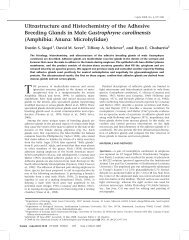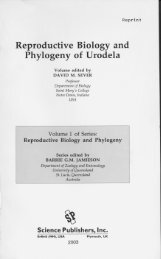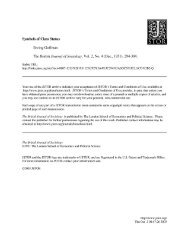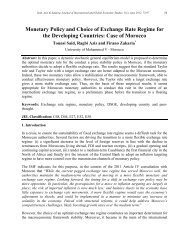Marvelous Facts and Miraculous Evidence in Early Modern Europe ...
Marvelous Facts and Miraculous Evidence in Early Modern Europe ...
Marvelous Facts and Miraculous Evidence in Early Modern Europe ...
Create successful ePaper yourself
Turn your PDF publications into a flip-book with our unique Google optimized e-Paper software.
98 Lorra<strong>in</strong>e Daston <strong>Facts</strong> <strong>and</strong> <strong>Evidence</strong><br />
miracles of sa<strong>in</strong>ts <strong>and</strong> their shr<strong>in</strong>es <strong>and</strong> relics, the miracles of the sac-<br />
raments, the miracles of judicial ordeals (at least until their abolition by<br />
the fourth Lateran Council <strong>in</strong> 1215), the historical miracles recounted by<br />
the chronicles, <strong>and</strong> the "jocular" miracles <strong>in</strong>serted <strong>in</strong> sermons all had to be<br />
subsumed there<strong>in</strong>, <strong>and</strong> the conceptual <strong>in</strong>tegrity of the category suffered<br />
accord<strong>in</strong>gly.9<br />
Nonetheless, the general outl<strong>in</strong>es of the doctr<strong>in</strong>e as it crystallized <strong>in</strong><br />
the thirteenth <strong>and</strong> fourteenth centuries can be discerned with some clarity.<br />
First, there was a tendency, always present among theologians <strong>and</strong><br />
<strong>in</strong>creas<strong>in</strong>gly pronounced after the Aristotelian synthesis of the thirteenth<br />
century, to segregate the natural <strong>and</strong> the preternatural from the supernatural,<br />
hav<strong>in</strong>g recourse to the latter only as a last resort. Second,<br />
although theologians followed Aqu<strong>in</strong>as <strong>in</strong> pr<strong>in</strong>ciple by def<strong>in</strong><strong>in</strong>g miracles<br />
by the abrogation of the lower order of causes, they also followed him <strong>in</strong><br />
practice by mak<strong>in</strong>g universal wonderment the actual criterion. Third,<br />
despite the ensu<strong>in</strong>g practical difficulties of dist<strong>in</strong>guish<strong>in</strong>g<br />
between the<br />
preternatural marvel <strong>and</strong> the supernatural miracle, theologians nonethe-<br />
less cont<strong>in</strong>ued to <strong>in</strong>sist on the theoretical dist<strong>in</strong>ction between the two.<br />
This dist<strong>in</strong>ction was fortified <strong>in</strong> the sixteenth century, when the pre-<br />
ternatural came to be ever more closely associated with the dubious <strong>and</strong><br />
possibly demonic activities of magic <strong>and</strong> div<strong>in</strong>ation.'0 Because of these<br />
demonic associations some historians have assumed that medieval theo-<br />
logians deemed theurgy to be supernatural, but this does not do justice<br />
to the nicety of the conceptual dist<strong>in</strong>ctions that reserved the supernat-<br />
ural for God alone. Although demons, astral <strong>in</strong>telligences, <strong>and</strong> other<br />
spirits might manipulate natural causes with superhuman dexterity <strong>and</strong><br />
thereby work marvels, as mere creatures they could never transcend<br />
from the preternatural to the supernatural <strong>and</strong> work genu<strong>in</strong>e miracles.<br />
Well <strong>in</strong>to the seventeenth century <strong>and</strong> beyond, sober th<strong>in</strong>kers warned<br />
aga<strong>in</strong>st the counterfeit miracles of Satan, who "be<strong>in</strong>g a natural Magician<br />
... may perform many acts <strong>in</strong> ways above our knowledge, though not<br />
transcend<strong>in</strong>g our natural power.""<br />
9. On shr<strong>in</strong>es <strong>and</strong> relics, seeJonathan Sumption, Pilgrimage: An Image ofMediaeval Reli-<br />
gion (London, 1975), pp. 22-44. On the trial by ordeal, see Robert Bartlett, Trial by Fire<br />
<strong>and</strong> Water: The MedievalJudicial Ordeal (Oxford, 1986). On sacramental <strong>and</strong> jocular miracles,<br />
see Benedicta Ward, Miracles <strong>and</strong> the Medieval M<strong>in</strong>d: Theory, Records, <strong>and</strong> Event, 1000-<br />
1215 (Philadelphia, 1982), pp. 13, 213. For a general survey of theological views on<br />
miracles, see Bernhard Bron, Das Wunder: Das theologische Wunderverst<strong>and</strong>nis im Horizont des<br />
neuzeitlichen Natur und Geschichtsbegriffs (G6tt<strong>in</strong>gen, 1975).<br />
10. See Jean Ceard, La Nature et les prodiges: L'Insolite au XVIe siecle, en France (Geneva,<br />
1977), pp. 111-15.<br />
11. Thomas Browne, Pseudodoxia Epidemica, <strong>in</strong> The Works of Sir Thomas Browne, ed.<br />
Charles Sayle, 3 vols. (Ed<strong>in</strong>burgh, 1912), 1:188. See William Fleetwood, An Essay upon Miracles,<br />
2d ed. (London, 1702), p. 108; hereafter abbreviated EM; <strong>and</strong> Joseph Glanvill,<br />
Sadducismus Triumphatus: Or, A full <strong>and</strong> pla<strong>in</strong> <strong>Evidence</strong>, Concern<strong>in</strong>g Witches <strong>and</strong> Apparitions<br />
(London, 1682), p. 52; hereafter abbreviated ST.







